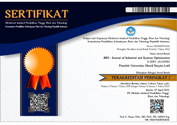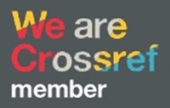SIX SIGMA IMPLEMENTATION IN "MONOSODIUM GLUTAMATE" PRODUCTION SYSTEMS
DOI:
https://doi.org/10.51804/jiso.v5i1.68-76Keywords:
Monosodium Glutamat, Six Sigma, DPMO, DMAIAbstract
Sebagai upaya untuk menjadi perusahaan yang kompetitif, PT GCK Indonesia sebagai salah satu produsen Monososium Glutamat di Indonesia, harus terus melakukan peningkatan sistem di segala sektor. Termasuk sistem produksi. Penelitian ini melakukan analisis perbaikan sistem produksi dan menelusuri produk cacat dengan penerapan metode Six Sigma. Data yang digunakan berasal dari hasil produksi selama enam bulan. Berdasarkan tahapan pengukuran, cacat produk memiliki nilai sigma sebesar 3,23 dengan nilai DPMO sebesar 275.586,22. Faktor manusia dan mesin adalah penyebab utama cacat. Perbaikan dilakukan dengan memperbaiki sistem perawatan mesin dan melengkapi prosedur operasi standar untuk setiap aktivitas kritis di lini produksi.
ABSTRACT
In order to gain competitive advantages, PT GCK Indonesia, as one of the Monosodium Glutamate producers in Indonesia, must continuously improve the system in all fields. Including the production system. This study used the Six Sigma method, which analyzed product defects. Data used comes from production results for six months. Based on the measurement stages, the product defect had a sigma value of 3.23 with a DPMO value of 275,586.22. Human and machine factors are the leading causes of defects. Improvements are made by correcting the machine maintenance system and completing standard operating procedures for each critical activity.
References
Cohen, A., Alhuraish, I., Robledo, C., & Kobi, A. (2020). A statistical analysis of critical quality tools and companies’ performance. Journal of Cleaner Production, 255, 120221. https://doi.org/10.1016/j.jclepro.2020.120221
Harmon, P. (2019). Incremental improvement with Lean and Six Sigma. In Business Process Change (pp. 283–314). Elsevier. https://doi.org/10.1016/B978-0-12-815847-0.00012-1
Ikumapayi, O. M., Akinlabi, E. T., Mwema, F. M., & Ogbonna, O. S. (2020). Six Sigma versus lean manufacturing – An overview. Materials Today: Proceedings, 26, 3275–3281. https://doi.org/10.1016/j.matpr.2020.02.986
Kiran, D. R. (2017). Quality Gurus. In Total Quality Management (pp. 21–37). Elsevier. https://doi.org/10.1016/B978-0-12-811035-5.00003-9
Kusuma, H. W. (2021). Effect of Service Quality on Consumer Satisfaction at the Jakarta Claim Center Division Pt. Wahana Tata Insurance. Journal of Economics, Finance And Management Studies, 04(09). https://doi.org/10.47191/jefms/v4-i9-13
Montgomery, D. C. (2019). Introduction to Statistical Quality Control (8th edition). Wiley.
Narasimhan, K. (2002). The Six Sigma Way: How GE, Motorola, and Other Top Companies Are Honing Their Performance. The TQM Magazine, 14(4), 263–264. https://doi.org/10.1108/tqmm.2002.14.4.263.1
Nayak, B., Bhattacharyya, S. S., & Krishnamoorthy, B. (2022). Exploring the black box of competitive advantage – An integrated bibliometric and chronological literature review approach. Journal of Business Research, 139, 964–982. https://doi.org/10.1016/j.jbusres.2021.10.047
Nurcahyo, R., Zulfadlillah, & Habiburrahman, M. (2021). Relationship between ISO 9001:2015 and operational and business performance of manufacturing industries in a developing country (Indonesia). Heliyon, 7(1), e05537. https://doi.org/10.1016/j.heliyon.2020.e05537
Pawar, H. U., Bagga, S. K., & Dubey, D. K. (2021). Investigation of production parameters for process capability analysis: A case study. Materials Today: Proceedings, 43, 196–202. https://doi.org/10.1016/j.matpr.2020.11.627
Santoso, A. A., & Fudhla, A. F. (2018). Perbaikan Sistem Produksi Kardus Dengan Pendekatan Lean DMAI Di PT Kedawung CCB. JISO : Journal of Industrial and Systems Optimization, 39–46. https://doi.org/10.51804/jiso.v1i1.39-46
Wang, H., Zhang, G., Zhou, S., & Ouyang, L. (2021). Implementation of a novel Six Sigma multi-objective robustness optimization method based on the improved response surface model for bumper system design. Thin-Walled Structures, 167, 108257. https://doi.org/10.1016/j.tws.2021.108257
Downloads
Published
Issue
Section
License
With the receipt of the article by JISO Editorial Board and the decision to be published, the copyright regarding the article will be transferred to JISO. The copyright transfer form can be downloaded here.
JISO has the right to multiply and distribute the article and every author is not allowed to publish the same article that was published in this journal.
JISO is licensed under a Creative Commons Attribution-ShareAlike 4.0 International License.
Under the following terms:
Attribution — You must give appropriate credit, provide a link to the license, and indicate if changes were made. You may do so in any reasonable manner, but not in any way that suggests the licensor endorses you or your use.
ShareAlike — If you remix, transform, or build upon the material, you must distribute your contributions under the same license as the original.














